Marketing Research: Gordon Ramsay Restaurant Expansion in India
VerifiedAdded on 2019/12/03
|12
|3804
|368
Report
AI Summary
This report presents an international market research plan focused on the potential expansion of Gordon Ramsay restaurants into the Indian market. It begins with an introduction that provides background information, the rationale behind the research, a problem statement, and the objectives of the study. A comprehensive literature review then examines the Indian restaurant industry, including quick service and fine dining sectors, key growth drivers such as rising consumerism and media exposure, and the challenges faced by global companies. The research approach is discussed, followed by an overview of appropriate data collection and analysis methods. The report concludes by addressing potential barriers and limitations encountered during the study. The report evaluates the market dynamics, competitive landscape, and consumer behavior to inform strategic decision-making for successful market entry and sustained growth. The research considers the operational challenges, regulatory aspects, and infrastructural issues that international companies face in the Indian market.

INTERNATIONAL MARKET
RESEARCH
RESEARCH
Paraphrase This Document
Need a fresh take? Get an instant paraphrase of this document with our AI Paraphraser
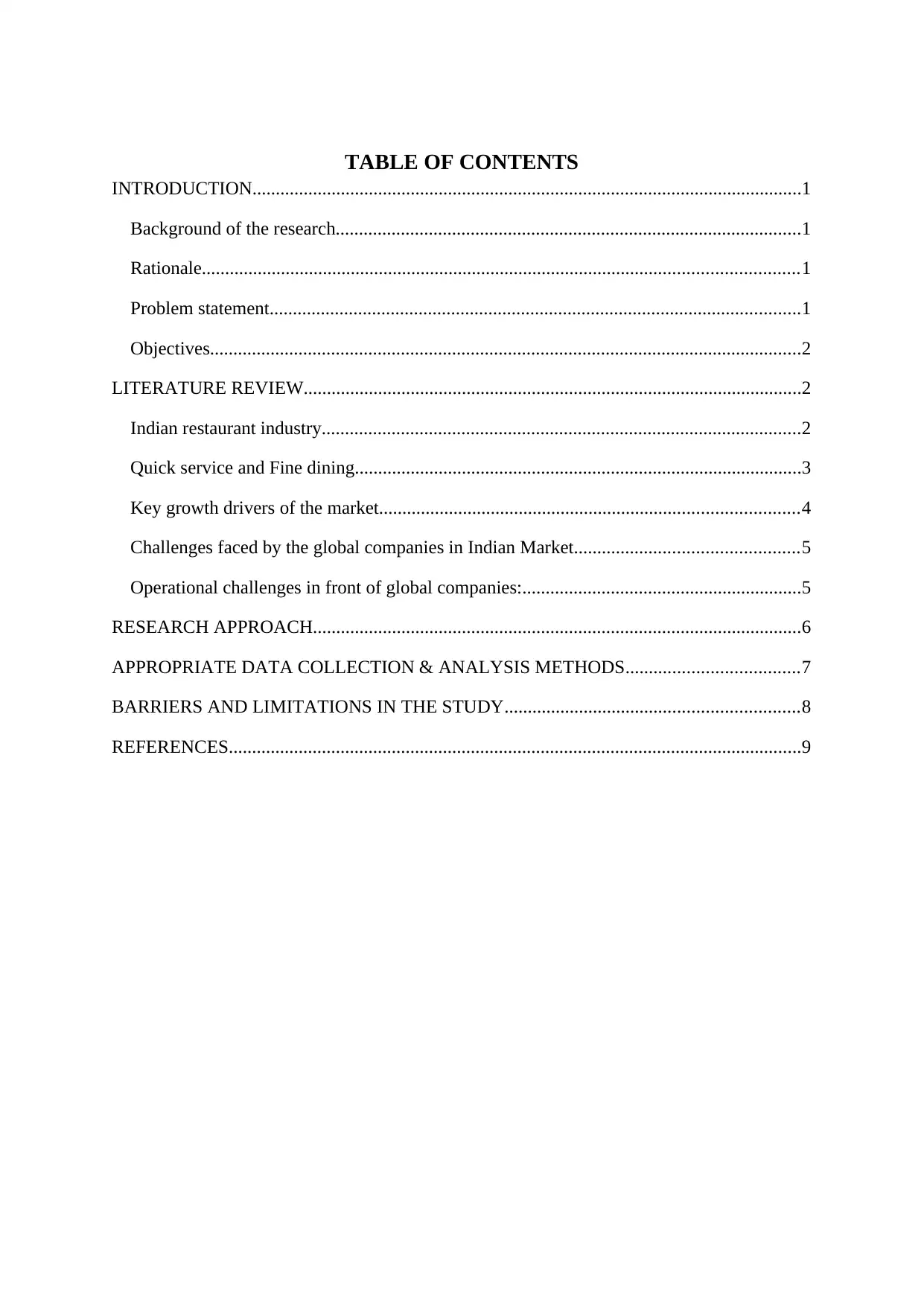
TABLE OF CONTENTS
INTRODUCTION......................................................................................................................1
Background of the research....................................................................................................1
Rationale................................................................................................................................1
Problem statement..................................................................................................................1
Objectives...............................................................................................................................2
LITERATURE REVIEW...........................................................................................................2
Indian restaurant industry.......................................................................................................2
Quick service and Fine dining................................................................................................3
Key growth drivers of the market..........................................................................................4
Challenges faced by the global companies in Indian Market................................................5
Operational challenges in front of global companies:............................................................5
RESEARCH APPROACH.........................................................................................................6
APPROPRIATE DATA COLLECTION & ANALYSIS METHODS.....................................7
BARRIERS AND LIMITATIONS IN THE STUDY...............................................................8
REFERENCES...........................................................................................................................9
INTRODUCTION......................................................................................................................1
Background of the research....................................................................................................1
Rationale................................................................................................................................1
Problem statement..................................................................................................................1
Objectives...............................................................................................................................2
LITERATURE REVIEW...........................................................................................................2
Indian restaurant industry.......................................................................................................2
Quick service and Fine dining................................................................................................3
Key growth drivers of the market..........................................................................................4
Challenges faced by the global companies in Indian Market................................................5
Operational challenges in front of global companies:............................................................5
RESEARCH APPROACH.........................................................................................................6
APPROPRIATE DATA COLLECTION & ANALYSIS METHODS.....................................7
BARRIERS AND LIMITATIONS IN THE STUDY...............................................................8
REFERENCES...........................................................................................................................9
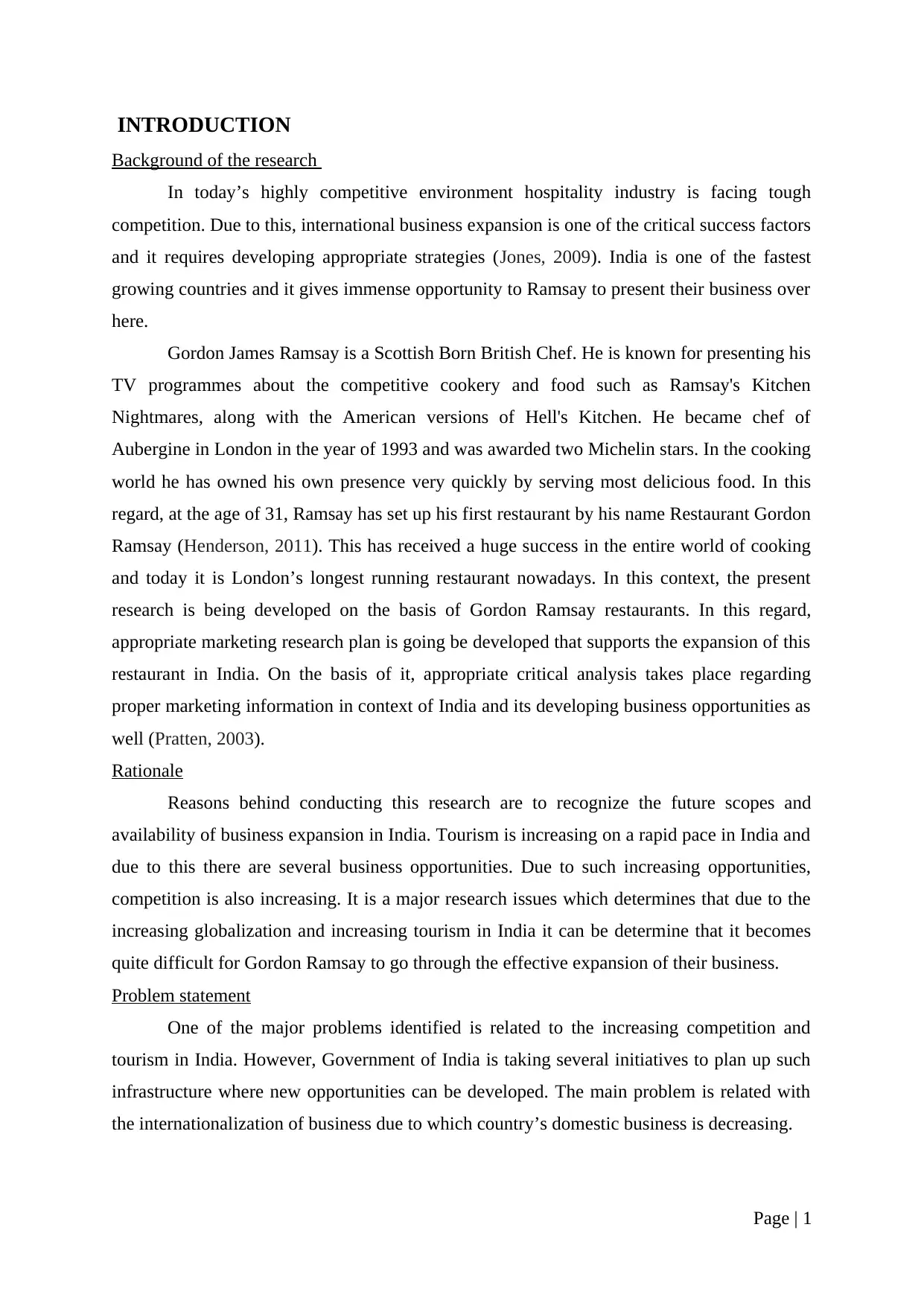
INTRODUCTION
Background of the research
In today’s highly competitive environment hospitality industry is facing tough
competition. Due to this, international business expansion is one of the critical success factors
and it requires developing appropriate strategies (Jones, 2009). India is one of the fastest
growing countries and it gives immense opportunity to Ramsay to present their business over
here.
Gordon James Ramsay is a Scottish Born British Chef. He is known for presenting his
TV programmes about the competitive cookery and food such as Ramsay's Kitchen
Nightmares, along with the American versions of Hell's Kitchen. He became chef of
Aubergine in London in the year of 1993 and was awarded two Michelin stars. In the cooking
world he has owned his own presence very quickly by serving most delicious food. In this
regard, at the age of 31, Ramsay has set up his first restaurant by his name Restaurant Gordon
Ramsay (Henderson, 2011). This has received a huge success in the entire world of cooking
and today it is London’s longest running restaurant nowadays. In this context, the present
research is being developed on the basis of Gordon Ramsay restaurants. In this regard,
appropriate marketing research plan is going be developed that supports the expansion of this
restaurant in India. On the basis of it, appropriate critical analysis takes place regarding
proper marketing information in context of India and its developing business opportunities as
well (Pratten, 2003).
Rationale
Reasons behind conducting this research are to recognize the future scopes and
availability of business expansion in India. Tourism is increasing on a rapid pace in India and
due to this there are several business opportunities. Due to such increasing opportunities,
competition is also increasing. It is a major research issues which determines that due to the
increasing globalization and increasing tourism in India it can be determine that it becomes
quite difficult for Gordon Ramsay to go through the effective expansion of their business.
Problem statement
One of the major problems identified is related to the increasing competition and
tourism in India. However, Government of India is taking several initiatives to plan up such
infrastructure where new opportunities can be developed. The main problem is related with
the internationalization of business due to which country’s domestic business is decreasing.
Page | 1
Background of the research
In today’s highly competitive environment hospitality industry is facing tough
competition. Due to this, international business expansion is one of the critical success factors
and it requires developing appropriate strategies (Jones, 2009). India is one of the fastest
growing countries and it gives immense opportunity to Ramsay to present their business over
here.
Gordon James Ramsay is a Scottish Born British Chef. He is known for presenting his
TV programmes about the competitive cookery and food such as Ramsay's Kitchen
Nightmares, along with the American versions of Hell's Kitchen. He became chef of
Aubergine in London in the year of 1993 and was awarded two Michelin stars. In the cooking
world he has owned his own presence very quickly by serving most delicious food. In this
regard, at the age of 31, Ramsay has set up his first restaurant by his name Restaurant Gordon
Ramsay (Henderson, 2011). This has received a huge success in the entire world of cooking
and today it is London’s longest running restaurant nowadays. In this context, the present
research is being developed on the basis of Gordon Ramsay restaurants. In this regard,
appropriate marketing research plan is going be developed that supports the expansion of this
restaurant in India. On the basis of it, appropriate critical analysis takes place regarding
proper marketing information in context of India and its developing business opportunities as
well (Pratten, 2003).
Rationale
Reasons behind conducting this research are to recognize the future scopes and
availability of business expansion in India. Tourism is increasing on a rapid pace in India and
due to this there are several business opportunities. Due to such increasing opportunities,
competition is also increasing. It is a major research issues which determines that due to the
increasing globalization and increasing tourism in India it can be determine that it becomes
quite difficult for Gordon Ramsay to go through the effective expansion of their business.
Problem statement
One of the major problems identified is related to the increasing competition and
tourism in India. However, Government of India is taking several initiatives to plan up such
infrastructure where new opportunities can be developed. The main problem is related with
the internationalization of business due to which country’s domestic business is decreasing.
Page | 1
⊘ This is a preview!⊘
Do you want full access?
Subscribe today to unlock all pages.

Trusted by 1+ million students worldwide
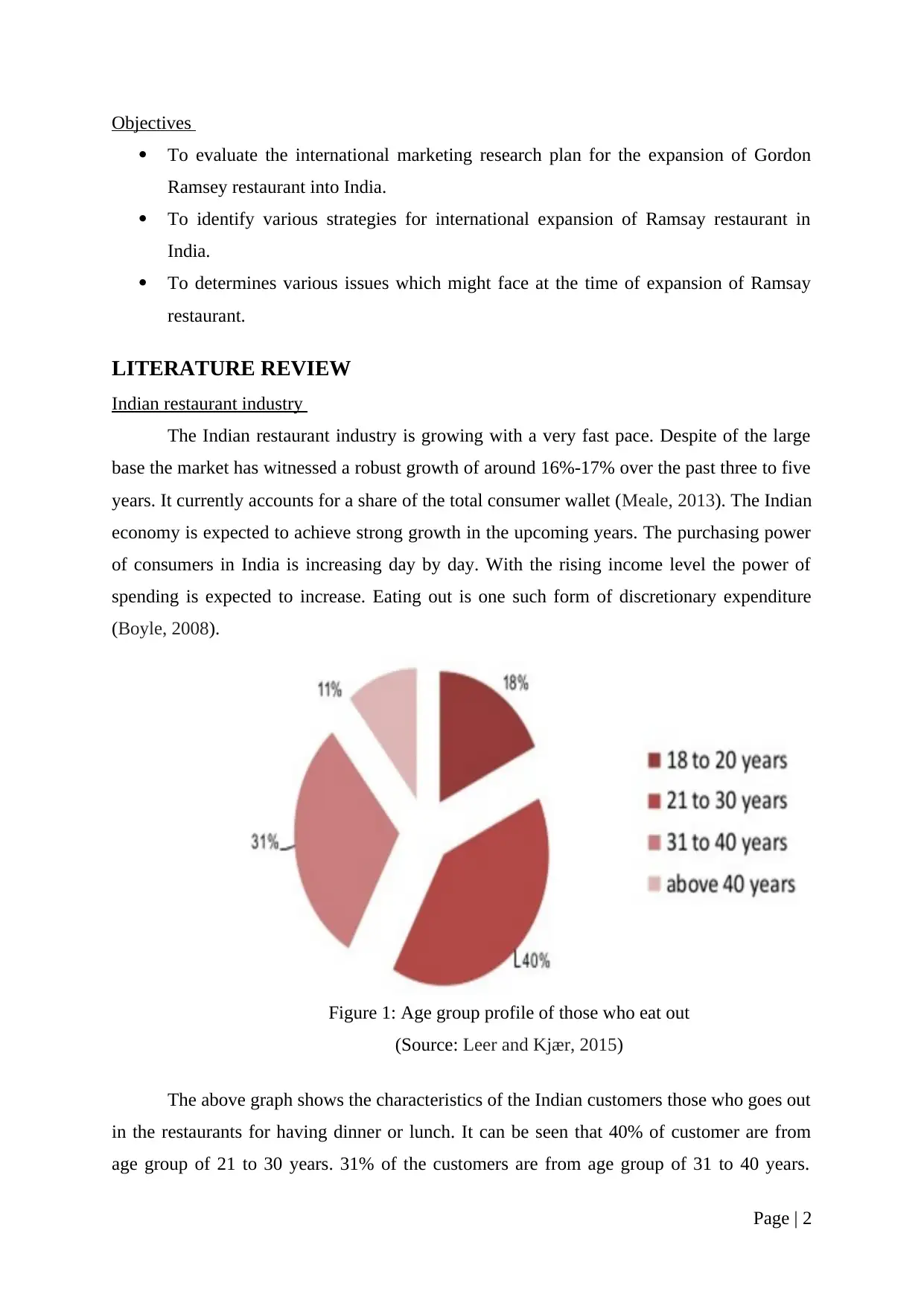
Objectives
To evaluate the international marketing research plan for the expansion of Gordon
Ramsey restaurant into India.
To identify various strategies for international expansion of Ramsay restaurant in
India.
To determines various issues which might face at the time of expansion of Ramsay
restaurant.
LITERATURE REVIEW
Indian restaurant industry
The Indian restaurant industry is growing with a very fast pace. Despite of the large
base the market has witnessed a robust growth of around 16%-17% over the past three to five
years. It currently accounts for a share of the total consumer wallet (Meale, 2013). The Indian
economy is expected to achieve strong growth in the upcoming years. The purchasing power
of consumers in India is increasing day by day. With the rising income level the power of
spending is expected to increase. Eating out is one such form of discretionary expenditure
(Boyle, 2008).
The above graph shows the characteristics of the Indian customers those who goes out
in the restaurants for having dinner or lunch. It can be seen that 40% of customer are from
age group of 21 to 30 years. 31% of the customers are from age group of 31 to 40 years.
Page | 2
Figure 1: Age group profile of those who eat out
(Source: Leer and Kjær, 2015)
To evaluate the international marketing research plan for the expansion of Gordon
Ramsey restaurant into India.
To identify various strategies for international expansion of Ramsay restaurant in
India.
To determines various issues which might face at the time of expansion of Ramsay
restaurant.
LITERATURE REVIEW
Indian restaurant industry
The Indian restaurant industry is growing with a very fast pace. Despite of the large
base the market has witnessed a robust growth of around 16%-17% over the past three to five
years. It currently accounts for a share of the total consumer wallet (Meale, 2013). The Indian
economy is expected to achieve strong growth in the upcoming years. The purchasing power
of consumers in India is increasing day by day. With the rising income level the power of
spending is expected to increase. Eating out is one such form of discretionary expenditure
(Boyle, 2008).
The above graph shows the characteristics of the Indian customers those who goes out
in the restaurants for having dinner or lunch. It can be seen that 40% of customer are from
age group of 21 to 30 years. 31% of the customers are from age group of 31 to 40 years.
Page | 2
Figure 1: Age group profile of those who eat out
(Source: Leer and Kjær, 2015)
Paraphrase This Document
Need a fresh take? Get an instant paraphrase of this document with our AI Paraphraser
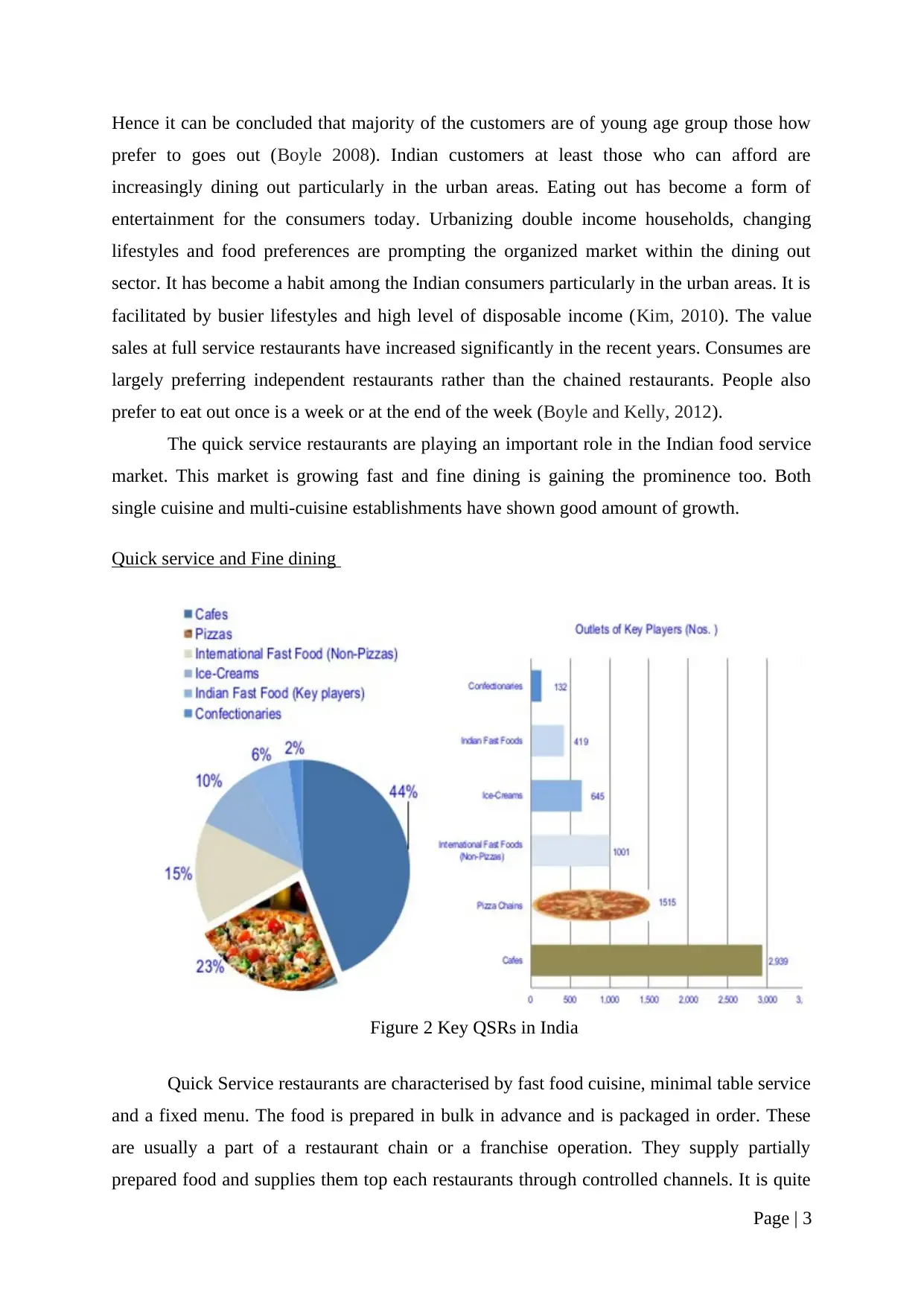
Hence it can be concluded that majority of the customers are of young age group those how
prefer to goes out (Boyle 2008). Indian customers at least those who can afford are
increasingly dining out particularly in the urban areas. Eating out has become a form of
entertainment for the consumers today. Urbanizing double income households, changing
lifestyles and food preferences are prompting the organized market within the dining out
sector. It has become a habit among the Indian consumers particularly in the urban areas. It is
facilitated by busier lifestyles and high level of disposable income (Kim, 2010). The value
sales at full service restaurants have increased significantly in the recent years. Consumes are
largely preferring independent restaurants rather than the chained restaurants. People also
prefer to eat out once is a week or at the end of the week (Boyle and Kelly, 2012).
The quick service restaurants are playing an important role in the Indian food service
market. This market is growing fast and fine dining is gaining the prominence too. Both
single cuisine and multi-cuisine establishments have shown good amount of growth.
Quick service and Fine dining
Quick Service restaurants are characterised by fast food cuisine, minimal table service
and a fixed menu. The food is prepared in bulk in advance and is packaged in order. These
are usually a part of a restaurant chain or a franchise operation. They supply partially
prepared food and supplies them top each restaurants through controlled channels. It is quite
Page | 3
Figure 2 Key QSRs in India
prefer to goes out (Boyle 2008). Indian customers at least those who can afford are
increasingly dining out particularly in the urban areas. Eating out has become a form of
entertainment for the consumers today. Urbanizing double income households, changing
lifestyles and food preferences are prompting the organized market within the dining out
sector. It has become a habit among the Indian consumers particularly in the urban areas. It is
facilitated by busier lifestyles and high level of disposable income (Kim, 2010). The value
sales at full service restaurants have increased significantly in the recent years. Consumes are
largely preferring independent restaurants rather than the chained restaurants. People also
prefer to eat out once is a week or at the end of the week (Boyle and Kelly, 2012).
The quick service restaurants are playing an important role in the Indian food service
market. This market is growing fast and fine dining is gaining the prominence too. Both
single cuisine and multi-cuisine establishments have shown good amount of growth.
Quick service and Fine dining
Quick Service restaurants are characterised by fast food cuisine, minimal table service
and a fixed menu. The food is prepared in bulk in advance and is packaged in order. These
are usually a part of a restaurant chain or a franchise operation. They supply partially
prepared food and supplies them top each restaurants through controlled channels. It is quite
Page | 3
Figure 2 Key QSRs in India
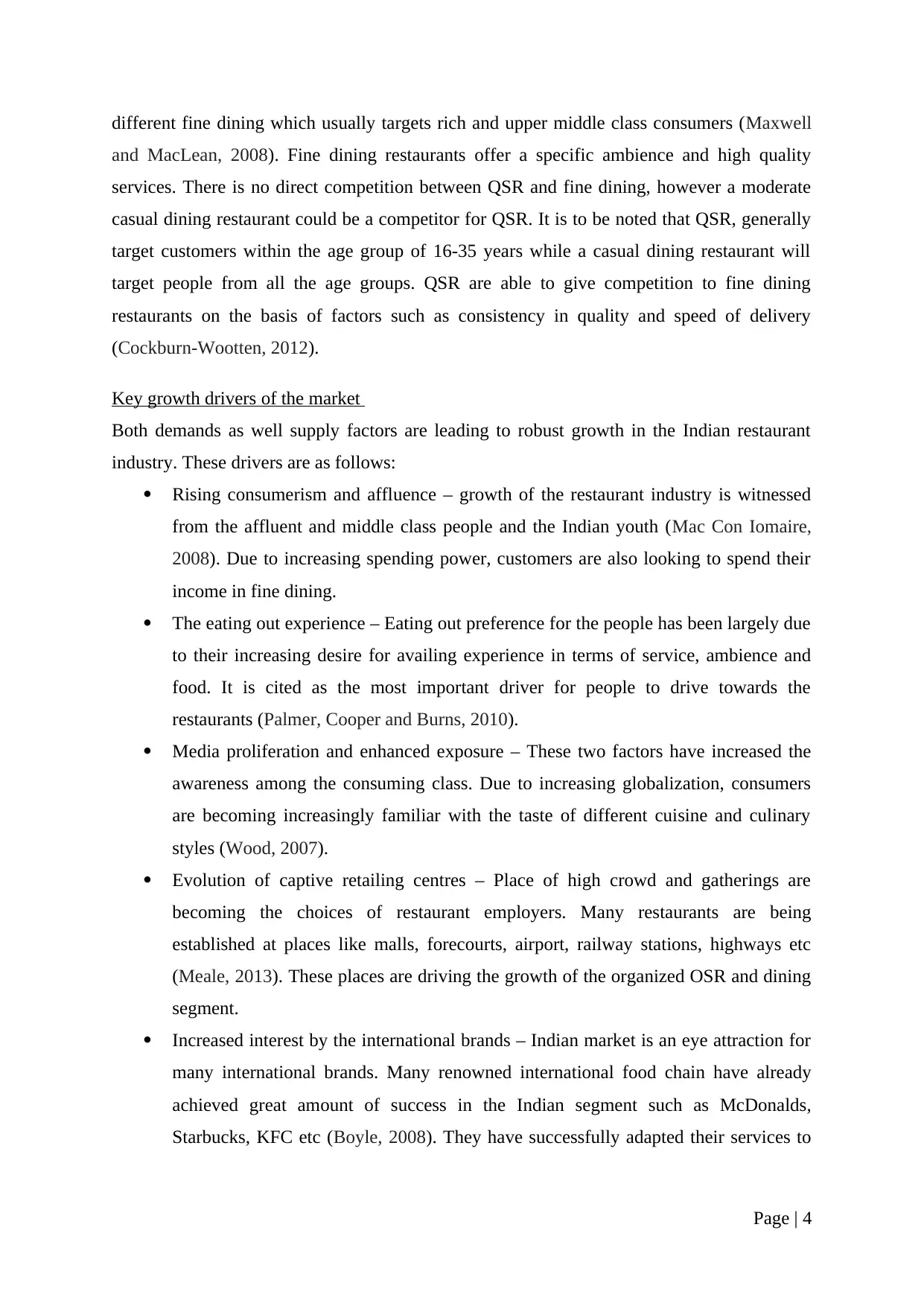
different fine dining which usually targets rich and upper middle class consumers (Maxwell
and MacLean, 2008). Fine dining restaurants offer a specific ambience and high quality
services. There is no direct competition between QSR and fine dining, however a moderate
casual dining restaurant could be a competitor for QSR. It is to be noted that QSR, generally
target customers within the age group of 16-35 years while a casual dining restaurant will
target people from all the age groups. QSR are able to give competition to fine dining
restaurants on the basis of factors such as consistency in quality and speed of delivery
(Cockburn-Wootten, 2012).
Key growth drivers of the market
Both demands as well supply factors are leading to robust growth in the Indian restaurant
industry. These drivers are as follows:
Rising consumerism and affluence – growth of the restaurant industry is witnessed
from the affluent and middle class people and the Indian youth (Mac Con Iomaire,
2008). Due to increasing spending power, customers are also looking to spend their
income in fine dining.
The eating out experience – Eating out preference for the people has been largely due
to their increasing desire for availing experience in terms of service, ambience and
food. It is cited as the most important driver for people to drive towards the
restaurants (Palmer, Cooper and Burns, 2010).
Media proliferation and enhanced exposure – These two factors have increased the
awareness among the consuming class. Due to increasing globalization, consumers
are becoming increasingly familiar with the taste of different cuisine and culinary
styles (Wood, 2007).
Evolution of captive retailing centres – Place of high crowd and gatherings are
becoming the choices of restaurant employers. Many restaurants are being
established at places like malls, forecourts, airport, railway stations, highways etc
(Meale, 2013). These places are driving the growth of the organized OSR and dining
segment.
Increased interest by the international brands – Indian market is an eye attraction for
many international brands. Many renowned international food chain have already
achieved great amount of success in the Indian segment such as McDonalds,
Starbucks, KFC etc (Boyle, 2008). They have successfully adapted their services to
Page | 4
and MacLean, 2008). Fine dining restaurants offer a specific ambience and high quality
services. There is no direct competition between QSR and fine dining, however a moderate
casual dining restaurant could be a competitor for QSR. It is to be noted that QSR, generally
target customers within the age group of 16-35 years while a casual dining restaurant will
target people from all the age groups. QSR are able to give competition to fine dining
restaurants on the basis of factors such as consistency in quality and speed of delivery
(Cockburn-Wootten, 2012).
Key growth drivers of the market
Both demands as well supply factors are leading to robust growth in the Indian restaurant
industry. These drivers are as follows:
Rising consumerism and affluence – growth of the restaurant industry is witnessed
from the affluent and middle class people and the Indian youth (Mac Con Iomaire,
2008). Due to increasing spending power, customers are also looking to spend their
income in fine dining.
The eating out experience – Eating out preference for the people has been largely due
to their increasing desire for availing experience in terms of service, ambience and
food. It is cited as the most important driver for people to drive towards the
restaurants (Palmer, Cooper and Burns, 2010).
Media proliferation and enhanced exposure – These two factors have increased the
awareness among the consuming class. Due to increasing globalization, consumers
are becoming increasingly familiar with the taste of different cuisine and culinary
styles (Wood, 2007).
Evolution of captive retailing centres – Place of high crowd and gatherings are
becoming the choices of restaurant employers. Many restaurants are being
established at places like malls, forecourts, airport, railway stations, highways etc
(Meale, 2013). These places are driving the growth of the organized OSR and dining
segment.
Increased interest by the international brands – Indian market is an eye attraction for
many international brands. Many renowned international food chain have already
achieved great amount of success in the Indian segment such as McDonalds,
Starbucks, KFC etc (Boyle, 2008). They have successfully adapted their services to
Page | 4
⊘ This is a preview!⊘
Do you want full access?
Subscribe today to unlock all pages.

Trusted by 1+ million students worldwide
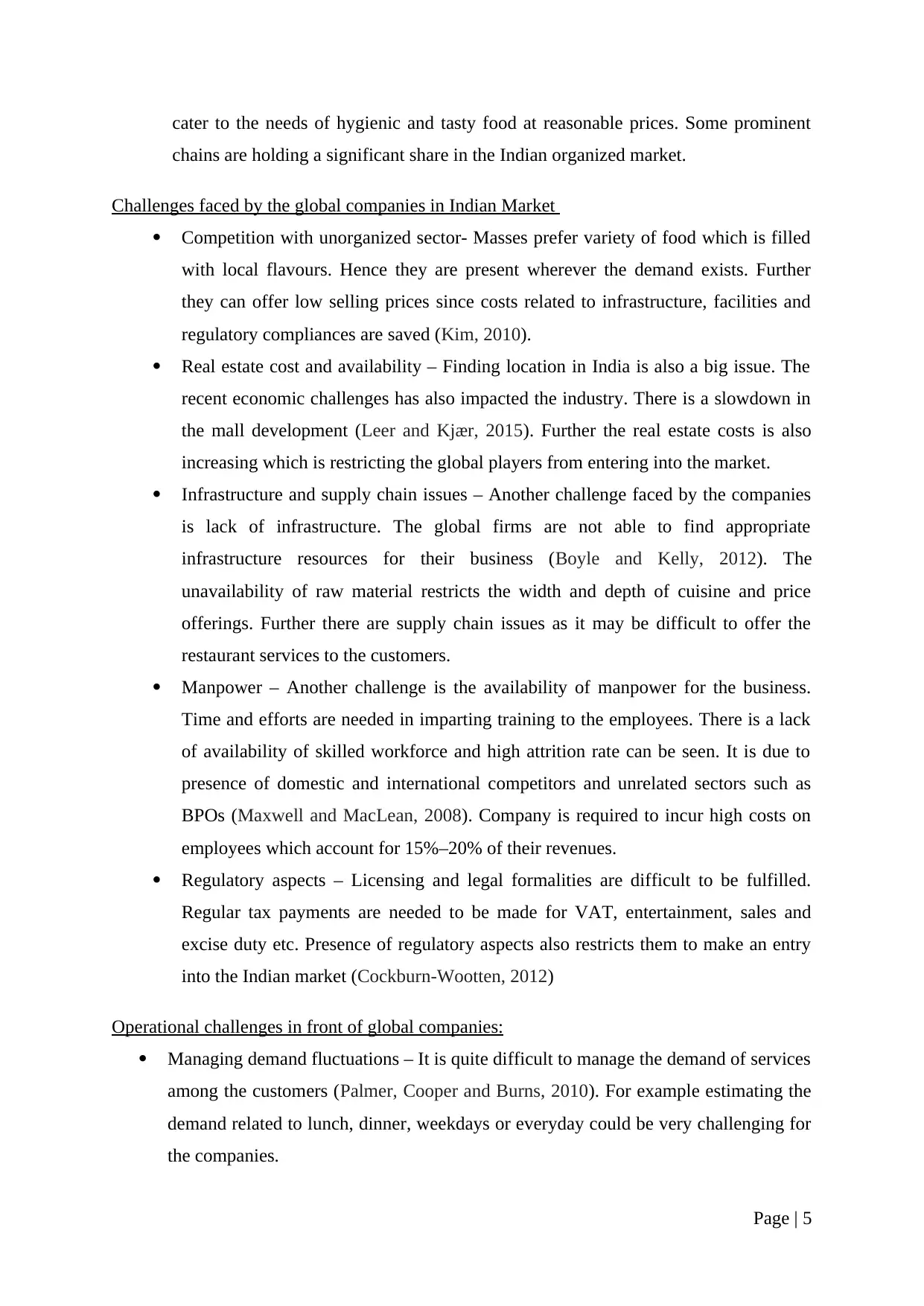
cater to the needs of hygienic and tasty food at reasonable prices. Some prominent
chains are holding a significant share in the Indian organized market.
Challenges faced by the global companies in Indian Market
Competition with unorganized sector- Masses prefer variety of food which is filled
with local flavours. Hence they are present wherever the demand exists. Further
they can offer low selling prices since costs related to infrastructure, facilities and
regulatory compliances are saved (Kim, 2010).
Real estate cost and availability – Finding location in India is also a big issue. The
recent economic challenges has also impacted the industry. There is a slowdown in
the mall development (Leer and Kjær, 2015). Further the real estate costs is also
increasing which is restricting the global players from entering into the market.
Infrastructure and supply chain issues – Another challenge faced by the companies
is lack of infrastructure. The global firms are not able to find appropriate
infrastructure resources for their business (Boyle and Kelly, 2012). The
unavailability of raw material restricts the width and depth of cuisine and price
offerings. Further there are supply chain issues as it may be difficult to offer the
restaurant services to the customers.
Manpower – Another challenge is the availability of manpower for the business.
Time and efforts are needed in imparting training to the employees. There is a lack
of availability of skilled workforce and high attrition rate can be seen. It is due to
presence of domestic and international competitors and unrelated sectors such as
BPOs (Maxwell and MacLean, 2008). Company is required to incur high costs on
employees which account for 15%–20% of their revenues.
Regulatory aspects – Licensing and legal formalities are difficult to be fulfilled.
Regular tax payments are needed to be made for VAT, entertainment, sales and
excise duty etc. Presence of regulatory aspects also restricts them to make an entry
into the Indian market (Cockburn-Wootten, 2012)
Operational challenges in front of global companies:
Managing demand fluctuations – It is quite difficult to manage the demand of services
among the customers (Palmer, Cooper and Burns, 2010). For example estimating the
demand related to lunch, dinner, weekdays or everyday could be very challenging for
the companies.
Page | 5
chains are holding a significant share in the Indian organized market.
Challenges faced by the global companies in Indian Market
Competition with unorganized sector- Masses prefer variety of food which is filled
with local flavours. Hence they are present wherever the demand exists. Further
they can offer low selling prices since costs related to infrastructure, facilities and
regulatory compliances are saved (Kim, 2010).
Real estate cost and availability – Finding location in India is also a big issue. The
recent economic challenges has also impacted the industry. There is a slowdown in
the mall development (Leer and Kjær, 2015). Further the real estate costs is also
increasing which is restricting the global players from entering into the market.
Infrastructure and supply chain issues – Another challenge faced by the companies
is lack of infrastructure. The global firms are not able to find appropriate
infrastructure resources for their business (Boyle and Kelly, 2012). The
unavailability of raw material restricts the width and depth of cuisine and price
offerings. Further there are supply chain issues as it may be difficult to offer the
restaurant services to the customers.
Manpower – Another challenge is the availability of manpower for the business.
Time and efforts are needed in imparting training to the employees. There is a lack
of availability of skilled workforce and high attrition rate can be seen. It is due to
presence of domestic and international competitors and unrelated sectors such as
BPOs (Maxwell and MacLean, 2008). Company is required to incur high costs on
employees which account for 15%–20% of their revenues.
Regulatory aspects – Licensing and legal formalities are difficult to be fulfilled.
Regular tax payments are needed to be made for VAT, entertainment, sales and
excise duty etc. Presence of regulatory aspects also restricts them to make an entry
into the Indian market (Cockburn-Wootten, 2012)
Operational challenges in front of global companies:
Managing demand fluctuations – It is quite difficult to manage the demand of services
among the customers (Palmer, Cooper and Burns, 2010). For example estimating the
demand related to lunch, dinner, weekdays or everyday could be very challenging for
the companies.
Page | 5
Paraphrase This Document
Need a fresh take? Get an instant paraphrase of this document with our AI Paraphraser
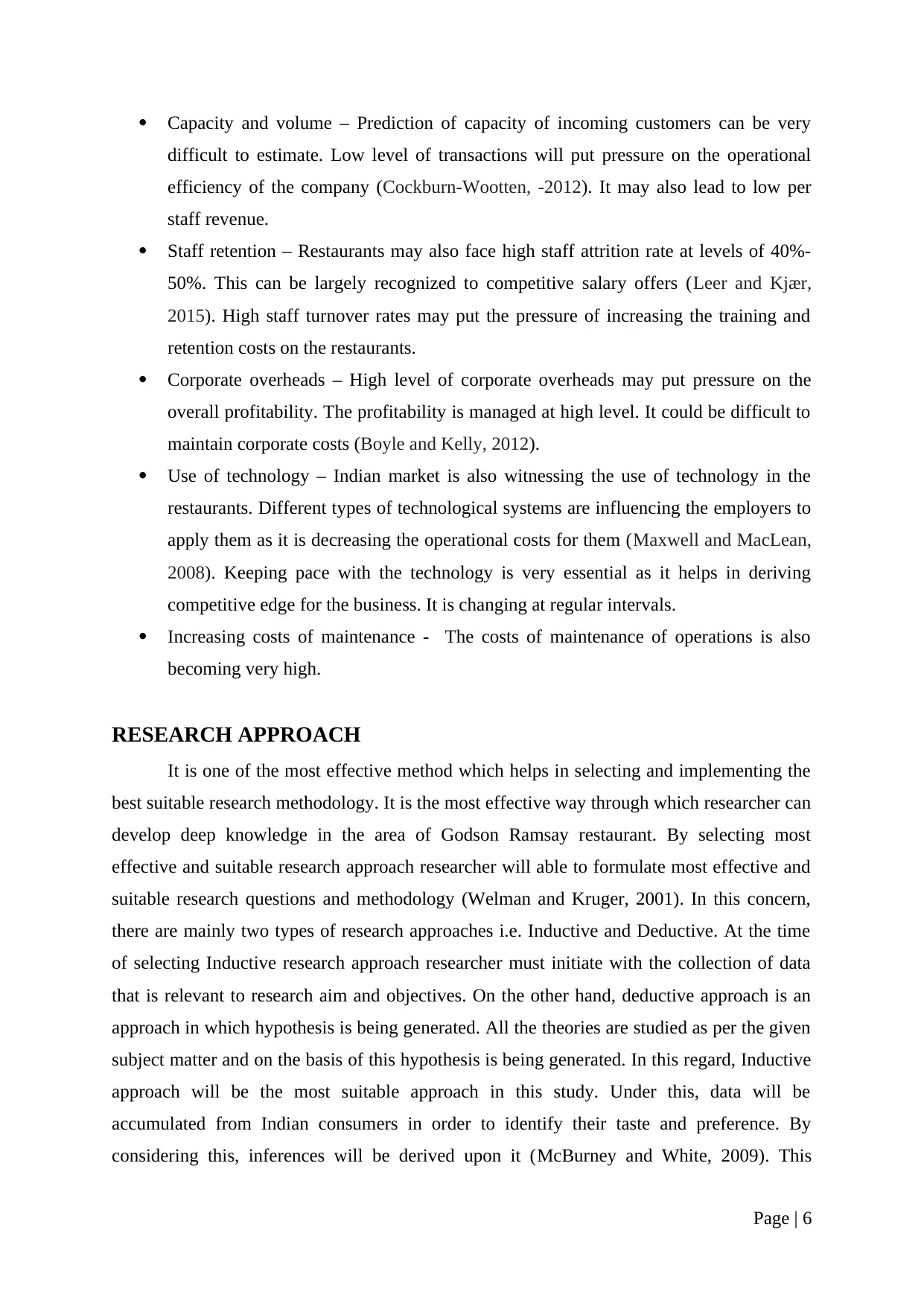
Capacity and volume – Prediction of capacity of incoming customers can be very
difficult to estimate. Low level of transactions will put pressure on the operational
efficiency of the company (Cockburn-Wootten, -2012). It may also lead to low per
staff revenue.
Staff retention – Restaurants may also face high staff attrition rate at levels of 40%-
50%. This can be largely recognized to competitive salary offers (Leer and Kjær,
2015). High staff turnover rates may put the pressure of increasing the training and
retention costs on the restaurants.
Corporate overheads – High level of corporate overheads may put pressure on the
overall profitability. The profitability is managed at high level. It could be difficult to
maintain corporate costs (Boyle and Kelly, 2012).
Use of technology – Indian market is also witnessing the use of technology in the
restaurants. Different types of technological systems are influencing the employers to
apply them as it is decreasing the operational costs for them (Maxwell and MacLean,
2008). Keeping pace with the technology is very essential as it helps in deriving
competitive edge for the business. It is changing at regular intervals.
Increasing costs of maintenance - The costs of maintenance of operations is also
becoming very high.
RESEARCH APPROACH
It is one of the most effective method which helps in selecting and implementing the
best suitable research methodology. It is the most effective way through which researcher can
develop deep knowledge in the area of Godson Ramsay restaurant. By selecting most
effective and suitable research approach researcher will able to formulate most effective and
suitable research questions and methodology (Welman and Kruger, 2001). In this concern,
there are mainly two types of research approaches i.e. Inductive and Deductive. At the time
of selecting Inductive research approach researcher must initiate with the collection of data
that is relevant to research aim and objectives. On the other hand, deductive approach is an
approach in which hypothesis is being generated. All the theories are studied as per the given
subject matter and on the basis of this hypothesis is being generated. In this regard, Inductive
approach will be the most suitable approach in this study. Under this, data will be
accumulated from Indian consumers in order to identify their taste and preference. By
considering this, inferences will be derived upon it (McBurney and White, 2009). This
Page | 6
difficult to estimate. Low level of transactions will put pressure on the operational
efficiency of the company (Cockburn-Wootten, -2012). It may also lead to low per
staff revenue.
Staff retention – Restaurants may also face high staff attrition rate at levels of 40%-
50%. This can be largely recognized to competitive salary offers (Leer and Kjær,
2015). High staff turnover rates may put the pressure of increasing the training and
retention costs on the restaurants.
Corporate overheads – High level of corporate overheads may put pressure on the
overall profitability. The profitability is managed at high level. It could be difficult to
maintain corporate costs (Boyle and Kelly, 2012).
Use of technology – Indian market is also witnessing the use of technology in the
restaurants. Different types of technological systems are influencing the employers to
apply them as it is decreasing the operational costs for them (Maxwell and MacLean,
2008). Keeping pace with the technology is very essential as it helps in deriving
competitive edge for the business. It is changing at regular intervals.
Increasing costs of maintenance - The costs of maintenance of operations is also
becoming very high.
RESEARCH APPROACH
It is one of the most effective method which helps in selecting and implementing the
best suitable research methodology. It is the most effective way through which researcher can
develop deep knowledge in the area of Godson Ramsay restaurant. By selecting most
effective and suitable research approach researcher will able to formulate most effective and
suitable research questions and methodology (Welman and Kruger, 2001). In this concern,
there are mainly two types of research approaches i.e. Inductive and Deductive. At the time
of selecting Inductive research approach researcher must initiate with the collection of data
that is relevant to research aim and objectives. On the other hand, deductive approach is an
approach in which hypothesis is being generated. All the theories are studied as per the given
subject matter and on the basis of this hypothesis is being generated. In this regard, Inductive
approach will be the most suitable approach in this study. Under this, data will be
accumulated from Indian consumers in order to identify their taste and preference. By
considering this, inferences will be derived upon it (McBurney and White, 2009). This
Page | 6
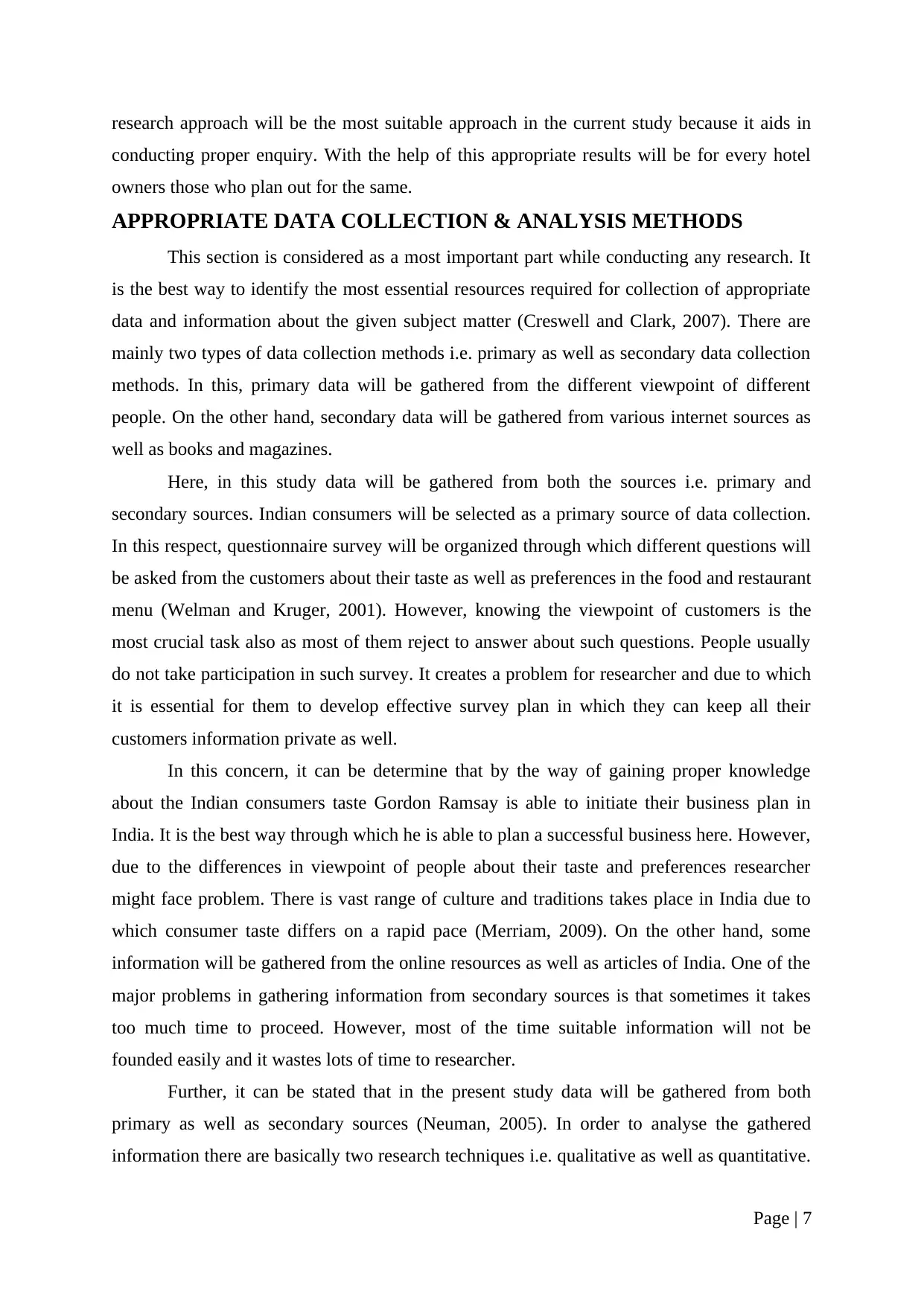
research approach will be the most suitable approach in the current study because it aids in
conducting proper enquiry. With the help of this appropriate results will be for every hotel
owners those who plan out for the same.
APPROPRIATE DATA COLLECTION & ANALYSIS METHODS
This section is considered as a most important part while conducting any research. It
is the best way to identify the most essential resources required for collection of appropriate
data and information about the given subject matter (Creswell and Clark, 2007). There are
mainly two types of data collection methods i.e. primary as well as secondary data collection
methods. In this, primary data will be gathered from the different viewpoint of different
people. On the other hand, secondary data will be gathered from various internet sources as
well as books and magazines.
Here, in this study data will be gathered from both the sources i.e. primary and
secondary sources. Indian consumers will be selected as a primary source of data collection.
In this respect, questionnaire survey will be organized through which different questions will
be asked from the customers about their taste as well as preferences in the food and restaurant
menu (Welman and Kruger, 2001). However, knowing the viewpoint of customers is the
most crucial task also as most of them reject to answer about such questions. People usually
do not take participation in such survey. It creates a problem for researcher and due to which
it is essential for them to develop effective survey plan in which they can keep all their
customers information private as well.
In this concern, it can be determine that by the way of gaining proper knowledge
about the Indian consumers taste Gordon Ramsay is able to initiate their business plan in
India. It is the best way through which he is able to plan a successful business here. However,
due to the differences in viewpoint of people about their taste and preferences researcher
might face problem. There is vast range of culture and traditions takes place in India due to
which consumer taste differs on a rapid pace (Merriam, 2009). On the other hand, some
information will be gathered from the online resources as well as articles of India. One of the
major problems in gathering information from secondary sources is that sometimes it takes
too much time to proceed. However, most of the time suitable information will not be
founded easily and it wastes lots of time to researcher.
Further, it can be stated that in the present study data will be gathered from both
primary as well as secondary sources (Neuman, 2005). In order to analyse the gathered
information there are basically two research techniques i.e. qualitative as well as quantitative.
Page | 7
conducting proper enquiry. With the help of this appropriate results will be for every hotel
owners those who plan out for the same.
APPROPRIATE DATA COLLECTION & ANALYSIS METHODS
This section is considered as a most important part while conducting any research. It
is the best way to identify the most essential resources required for collection of appropriate
data and information about the given subject matter (Creswell and Clark, 2007). There are
mainly two types of data collection methods i.e. primary as well as secondary data collection
methods. In this, primary data will be gathered from the different viewpoint of different
people. On the other hand, secondary data will be gathered from various internet sources as
well as books and magazines.
Here, in this study data will be gathered from both the sources i.e. primary and
secondary sources. Indian consumers will be selected as a primary source of data collection.
In this respect, questionnaire survey will be organized through which different questions will
be asked from the customers about their taste as well as preferences in the food and restaurant
menu (Welman and Kruger, 2001). However, knowing the viewpoint of customers is the
most crucial task also as most of them reject to answer about such questions. People usually
do not take participation in such survey. It creates a problem for researcher and due to which
it is essential for them to develop effective survey plan in which they can keep all their
customers information private as well.
In this concern, it can be determine that by the way of gaining proper knowledge
about the Indian consumers taste Gordon Ramsay is able to initiate their business plan in
India. It is the best way through which he is able to plan a successful business here. However,
due to the differences in viewpoint of people about their taste and preferences researcher
might face problem. There is vast range of culture and traditions takes place in India due to
which consumer taste differs on a rapid pace (Merriam, 2009). On the other hand, some
information will be gathered from the online resources as well as articles of India. One of the
major problems in gathering information from secondary sources is that sometimes it takes
too much time to proceed. However, most of the time suitable information will not be
founded easily and it wastes lots of time to researcher.
Further, it can be stated that in the present study data will be gathered from both
primary as well as secondary sources (Neuman, 2005). In order to analyse the gathered
information there are basically two research techniques i.e. qualitative as well as quantitative.
Page | 7
⊘ This is a preview!⊘
Do you want full access?
Subscribe today to unlock all pages.

Trusted by 1+ million students worldwide
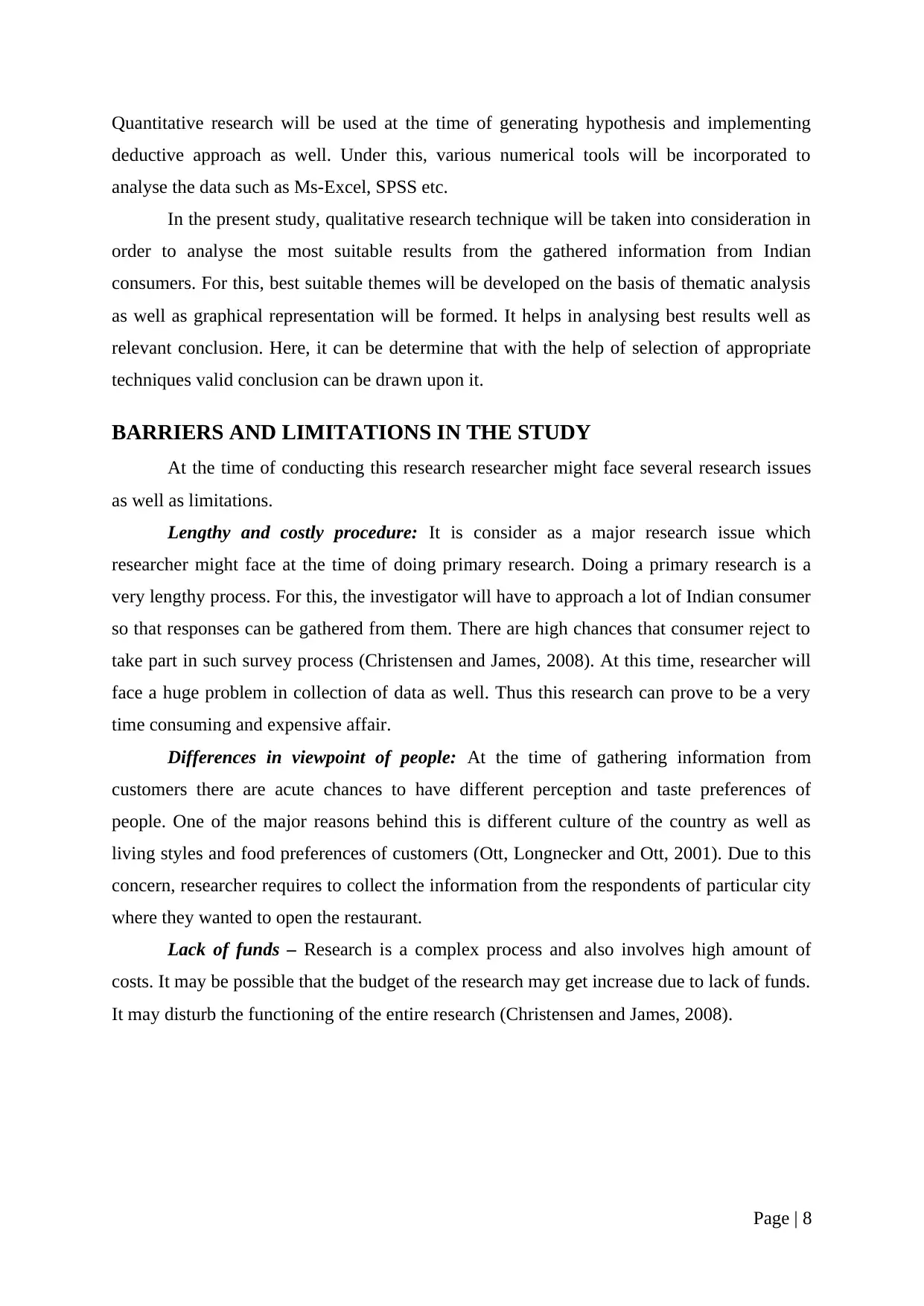
Quantitative research will be used at the time of generating hypothesis and implementing
deductive approach as well. Under this, various numerical tools will be incorporated to
analyse the data such as Ms-Excel, SPSS etc.
In the present study, qualitative research technique will be taken into consideration in
order to analyse the most suitable results from the gathered information from Indian
consumers. For this, best suitable themes will be developed on the basis of thematic analysis
as well as graphical representation will be formed. It helps in analysing best results well as
relevant conclusion. Here, it can be determine that with the help of selection of appropriate
techniques valid conclusion can be drawn upon it.
BARRIERS AND LIMITATIONS IN THE STUDY
At the time of conducting this research researcher might face several research issues
as well as limitations.
Lengthy and costly procedure: It is consider as a major research issue which
researcher might face at the time of doing primary research. Doing a primary research is a
very lengthy process. For this, the investigator will have to approach a lot of Indian consumer
so that responses can be gathered from them. There are high chances that consumer reject to
take part in such survey process (Christensen and James, 2008). At this time, researcher will
face a huge problem in collection of data as well. Thus this research can prove to be a very
time consuming and expensive affair.
Differences in viewpoint of people: At the time of gathering information from
customers there are acute chances to have different perception and taste preferences of
people. One of the major reasons behind this is different culture of the country as well as
living styles and food preferences of customers (Ott, Longnecker and Ott, 2001). Due to this
concern, researcher requires to collect the information from the respondents of particular city
where they wanted to open the restaurant.
Lack of funds – Research is a complex process and also involves high amount of
costs. It may be possible that the budget of the research may get increase due to lack of funds.
It may disturb the functioning of the entire research (Christensen and James, 2008).
Page | 8
deductive approach as well. Under this, various numerical tools will be incorporated to
analyse the data such as Ms-Excel, SPSS etc.
In the present study, qualitative research technique will be taken into consideration in
order to analyse the most suitable results from the gathered information from Indian
consumers. For this, best suitable themes will be developed on the basis of thematic analysis
as well as graphical representation will be formed. It helps in analysing best results well as
relevant conclusion. Here, it can be determine that with the help of selection of appropriate
techniques valid conclusion can be drawn upon it.
BARRIERS AND LIMITATIONS IN THE STUDY
At the time of conducting this research researcher might face several research issues
as well as limitations.
Lengthy and costly procedure: It is consider as a major research issue which
researcher might face at the time of doing primary research. Doing a primary research is a
very lengthy process. For this, the investigator will have to approach a lot of Indian consumer
so that responses can be gathered from them. There are high chances that consumer reject to
take part in such survey process (Christensen and James, 2008). At this time, researcher will
face a huge problem in collection of data as well. Thus this research can prove to be a very
time consuming and expensive affair.
Differences in viewpoint of people: At the time of gathering information from
customers there are acute chances to have different perception and taste preferences of
people. One of the major reasons behind this is different culture of the country as well as
living styles and food preferences of customers (Ott, Longnecker and Ott, 2001). Due to this
concern, researcher requires to collect the information from the respondents of particular city
where they wanted to open the restaurant.
Lack of funds – Research is a complex process and also involves high amount of
costs. It may be possible that the budget of the research may get increase due to lack of funds.
It may disturb the functioning of the entire research (Christensen and James, 2008).
Page | 8
Paraphrase This Document
Need a fresh take? Get an instant paraphrase of this document with our AI Paraphraser
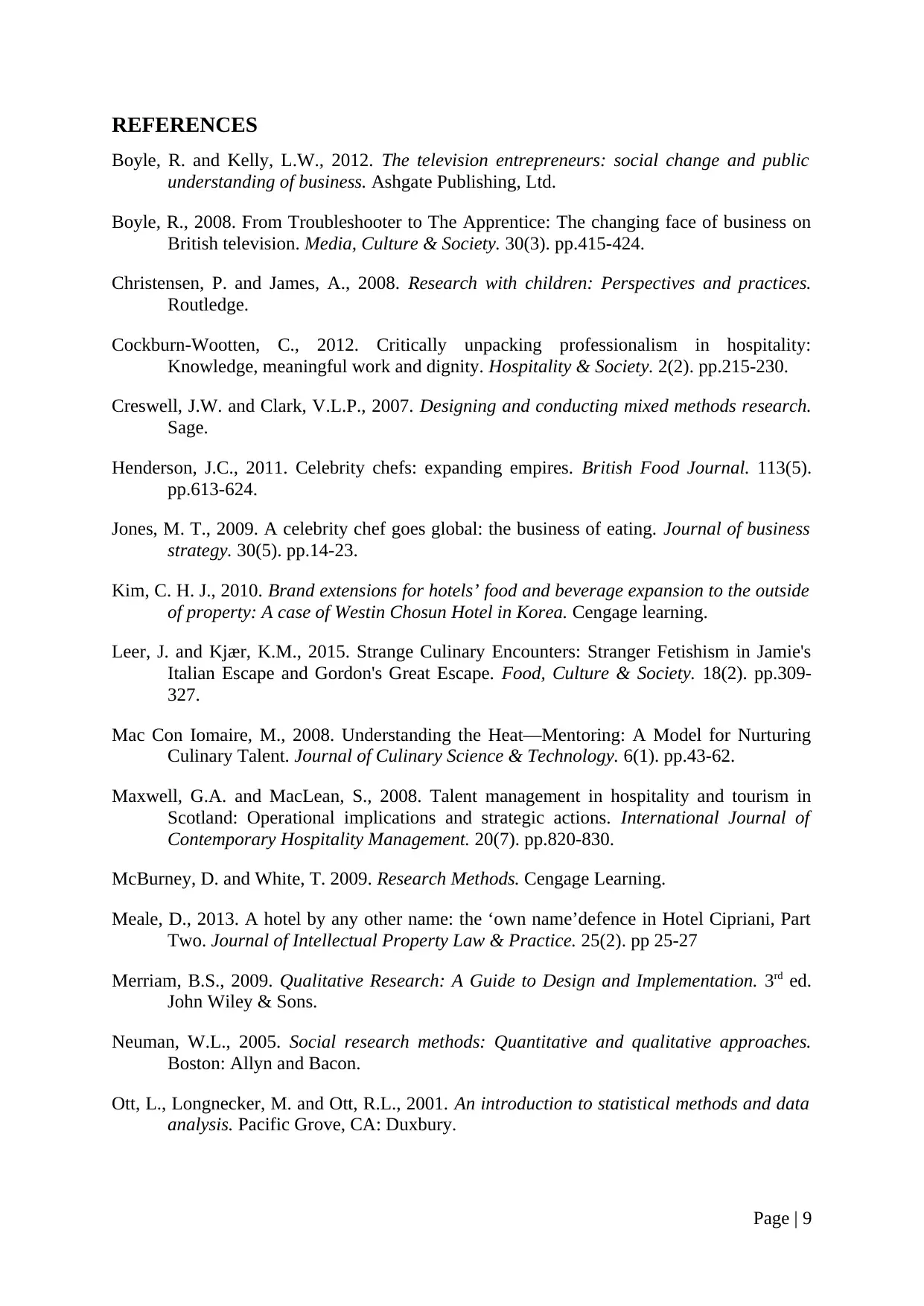
REFERENCES
Boyle, R. and Kelly, L.W., 2012. The television entrepreneurs: social change and public
understanding of business. Ashgate Publishing, Ltd.
Boyle, R., 2008. From Troubleshooter to The Apprentice: The changing face of business on
British television. Media, Culture & Society. 30(3). pp.415-424.
Christensen, P. and James, A., 2008. Research with children: Perspectives and practices.
Routledge.
Cockburn-Wootten, C., 2012. Critically unpacking professionalism in hospitality:
Knowledge, meaningful work and dignity. Hospitality & Society. 2(2). pp.215-230.
Creswell, J.W. and Clark, V.L.P., 2007. Designing and conducting mixed methods research.
Sage.
Henderson, J.C., 2011. Celebrity chefs: expanding empires. British Food Journal. 113(5).
pp.613-624.
Jones, M. T., 2009. A celebrity chef goes global: the business of eating. Journal of business
strategy. 30(5). pp.14-23.
Kim, C. H. J., 2010. Brand extensions for hotels’ food and beverage expansion to the outside
of property: A case of Westin Chosun Hotel in Korea. Cengage learning.
Leer, J. and Kjær, K.M., 2015. Strange Culinary Encounters: Stranger Fetishism in Jamie's
Italian Escape and Gordon's Great Escape. Food, Culture & Society. 18(2). pp.309-
327.
Mac Con Iomaire, M., 2008. Understanding the Heat—Mentoring: A Model for Nurturing
Culinary Talent. Journal of Culinary Science & Technology. 6(1). pp.43-62.
Maxwell, G.A. and MacLean, S., 2008. Talent management in hospitality and tourism in
Scotland: Operational implications and strategic actions. International Journal of
Contemporary Hospitality Management. 20(7). pp.820-830.
McBurney, D. and White, T. 2009. Research Methods. Cengage Learning.
Meale, D., 2013. A hotel by any other name: the ‘own name’defence in Hotel Cipriani, Part
Two. Journal of Intellectual Property Law & Practice. 25(2). pp 25-27
Merriam, B.S., 2009. Qualitative Research: A Guide to Design and Implementation. 3rd ed.
John Wiley & Sons.
Neuman, W.L., 2005. Social research methods: Quantitative and qualitative approaches.
Boston: Allyn and Bacon.
Ott, L., Longnecker, M. and Ott, R.L., 2001. An introduction to statistical methods and data
analysis. Pacific Grove, CA: Duxbury.
Page | 9
Boyle, R. and Kelly, L.W., 2012. The television entrepreneurs: social change and public
understanding of business. Ashgate Publishing, Ltd.
Boyle, R., 2008. From Troubleshooter to The Apprentice: The changing face of business on
British television. Media, Culture & Society. 30(3). pp.415-424.
Christensen, P. and James, A., 2008. Research with children: Perspectives and practices.
Routledge.
Cockburn-Wootten, C., 2012. Critically unpacking professionalism in hospitality:
Knowledge, meaningful work and dignity. Hospitality & Society. 2(2). pp.215-230.
Creswell, J.W. and Clark, V.L.P., 2007. Designing and conducting mixed methods research.
Sage.
Henderson, J.C., 2011. Celebrity chefs: expanding empires. British Food Journal. 113(5).
pp.613-624.
Jones, M. T., 2009. A celebrity chef goes global: the business of eating. Journal of business
strategy. 30(5). pp.14-23.
Kim, C. H. J., 2010. Brand extensions for hotels’ food and beverage expansion to the outside
of property: A case of Westin Chosun Hotel in Korea. Cengage learning.
Leer, J. and Kjær, K.M., 2015. Strange Culinary Encounters: Stranger Fetishism in Jamie's
Italian Escape and Gordon's Great Escape. Food, Culture & Society. 18(2). pp.309-
327.
Mac Con Iomaire, M., 2008. Understanding the Heat—Mentoring: A Model for Nurturing
Culinary Talent. Journal of Culinary Science & Technology. 6(1). pp.43-62.
Maxwell, G.A. and MacLean, S., 2008. Talent management in hospitality and tourism in
Scotland: Operational implications and strategic actions. International Journal of
Contemporary Hospitality Management. 20(7). pp.820-830.
McBurney, D. and White, T. 2009. Research Methods. Cengage Learning.
Meale, D., 2013. A hotel by any other name: the ‘own name’defence in Hotel Cipriani, Part
Two. Journal of Intellectual Property Law & Practice. 25(2). pp 25-27
Merriam, B.S., 2009. Qualitative Research: A Guide to Design and Implementation. 3rd ed.
John Wiley & Sons.
Neuman, W.L., 2005. Social research methods: Quantitative and qualitative approaches.
Boston: Allyn and Bacon.
Ott, L., Longnecker, M. and Ott, R.L., 2001. An introduction to statistical methods and data
analysis. Pacific Grove, CA: Duxbury.
Page | 9
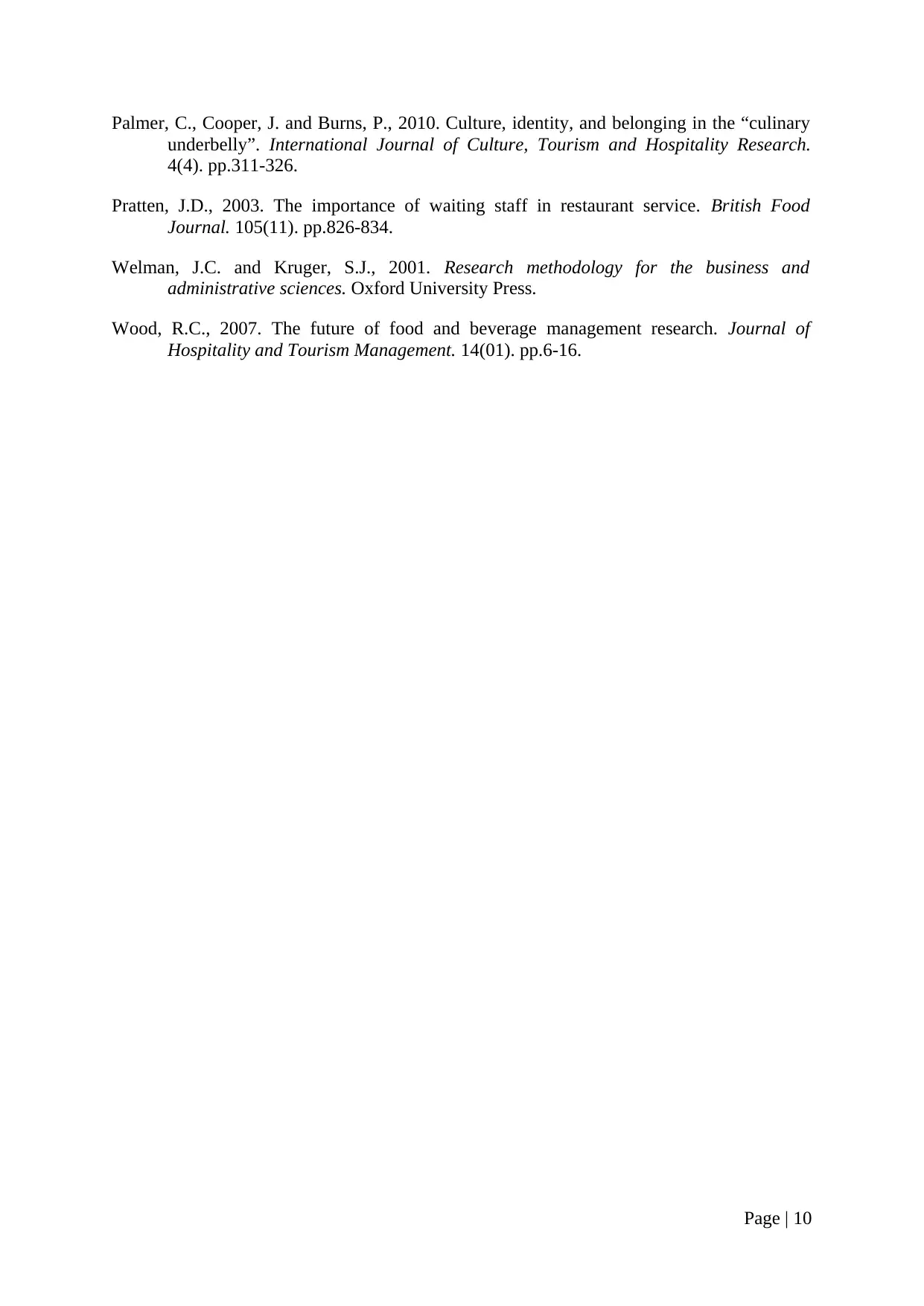
Palmer, C., Cooper, J. and Burns, P., 2010. Culture, identity, and belonging in the “culinary
underbelly”. International Journal of Culture, Tourism and Hospitality Research.
4(4). pp.311-326.
Pratten, J.D., 2003. The importance of waiting staff in restaurant service. British Food
Journal. 105(11). pp.826-834.
Welman, J.C. and Kruger, S.J., 2001. Research methodology for the business and
administrative sciences. Oxford University Press.
Wood, R.C., 2007. The future of food and beverage management research. Journal of
Hospitality and Tourism Management. 14(01). pp.6-16.
Page | 10
underbelly”. International Journal of Culture, Tourism and Hospitality Research.
4(4). pp.311-326.
Pratten, J.D., 2003. The importance of waiting staff in restaurant service. British Food
Journal. 105(11). pp.826-834.
Welman, J.C. and Kruger, S.J., 2001. Research methodology for the business and
administrative sciences. Oxford University Press.
Wood, R.C., 2007. The future of food and beverage management research. Journal of
Hospitality and Tourism Management. 14(01). pp.6-16.
Page | 10
⊘ This is a preview!⊘
Do you want full access?
Subscribe today to unlock all pages.

Trusted by 1+ million students worldwide
1 out of 12
Related Documents
Your All-in-One AI-Powered Toolkit for Academic Success.
+13062052269
info@desklib.com
Available 24*7 on WhatsApp / Email
![[object Object]](/_next/static/media/star-bottom.7253800d.svg)
Unlock your academic potential
Copyright © 2020–2025 A2Z Services. All Rights Reserved. Developed and managed by ZUCOL.




